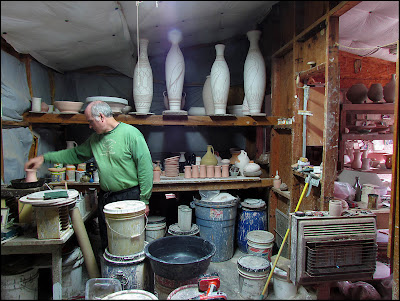Glazing... and Patience when Potting
Yesterday was a long day of preparing pots for glazing and glazing and loading the electric kiln for the last firing before Christmas. I always have a few pots promised to some customers this time of year that I try to squeeze out at the last minute. But in order to fire a few pots, I need to fire a whole kiln.
 Levi created a wonderful bunch of plates and platters, carving some intricate designs (picture at right) into a porcelain slip on top of a brown clay. I've been putting off firing some of them because they require quite a bit of clean up.
Levi created a wonderful bunch of plates and platters, carving some intricate designs (picture at right) into a porcelain slip on top of a brown clay. I've been putting off firing some of them because they require quite a bit of clean up.This particular bunch of plates had a lot of nasty sharp edges that needed to be cleaned up before glazing (picture at left).
 I had tried to clean some up when they were just greenware (unfired) with a little scrubby, but I found myself scrubbing too much slip off the designs.
I had tried to clean some up when they were just greenware (unfired) with a little scrubby, but I found myself scrubbing too much slip off the designs.So, I opted to bisque fire them and carefully clean them up with a bit of sand paper. The problem with sharp bits of clay on pieces is that they can become razor sharp after they're fired to high temperatures, and somebody could cut their finger on a piece.
The secret to getting clean lines when carving is using the right tool and working on the piece at the right time. If the clay is too soft, the tool will end up pushing clay aside while cutting and you'll get sharp edges. If you wait until the clay has dried just enough, the tool can cut through the clay cleanly and you end up with much less cleanup involved.
There's a lot of waiting involved in making pottery, and depending on what you do to a piece before it dries, you've got to keep a lot of pots from drying out too fast. The top of a pot left exposed to air will dry out faster than the bottom of a pot, so sometimes you have to lay a piece of plastic on top of a row of pots to slow down the drying.
You might be mentally ready to decorate a group of pots - or put handles on them - but they're not ready. So, you cover them up for the night, and uncover them in the morning, and wait for them to dry a bit more.
Now, I'm waiting for that kiln to cool, so I can see the results from a day of hard work in the glaze room. I glazed Levi's plates with a blue ash glaze - a light spraying of the glaze on the two plates - and I'm hoping for some dramatic results.


